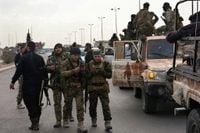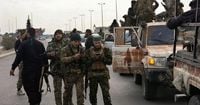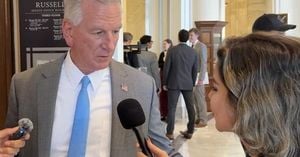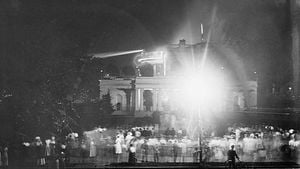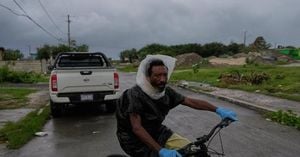Clashes erupted this week in northern Syria’s Idlib province, highlighting the deepening dilemma facing the country’s interim authorities as they grapple with the thorny issue of foreign Islamist militants. According to the Associated Press, fighting broke out between Syrian government forces and militants led by Omar Diaby, a Senegal-born French national with a notorious reputation across Europe and the Middle East. The unrest unfolded in the Al-Fardan camp, situated near the Turkish border, and has thrown a spotlight on the broader question of what to do with thousands of foreign fighters who poured into Syria during its long and bloody civil war.
The Al-Fardan camp, according to Syria’s Interior Ministry, is home to a small but significant group of French and Francophone militants and their families. The ministry stated on Wednesday, October 22, 2025, that security forces surrounded the camp after receiving complaints of serious violations. Chief among these was the kidnapping of a young girl by an armed group led by Diaby. The situation escalated quickly—Diaby reportedly refused to surrender, barricading himself inside the camp, preventing civilians from leaving, and opening fire on security personnel. The ministry accused him of “provoking security personnel, and terrorizing residents.”
The standoff rapidly intensified. SARI Global, a center for geopolitical and security analysis, reported that armed clashes broke out overnight from Tuesday into Wednesday, with intense exchanges of gunfire and drone strikes rocking the camp. The exact toll remains unclear, but videos circulating on social media showed the aftermath: shattered walls and windows, and panicked women and children fleeing under the escort of armed men. One particularly striking video showed Omar Diaby’s son, Jibril, appealing to Syrians: “We have families and children and orphans and women here, including elderly women. We are your brothers, the immigrants who left our lands and our families and everything behind us to come and help you when you were saying, ‘Where is the world? Where are the Arabs? Where is the Islamic nation?’ Now you have turned on us.”
The situation threatened to spiral further as another group of foreign militants—this time from Uzbekistan—flocked to the area, preparing to defend the camp. According to Wassim Nasr, a senior research fellow at the Soufan Center, this development, combined with fears of political fallout should women and children be harmed, prompted government forces to halt their assault. Instead, both sides reached a truce: Diaby agreed to hand over the camp’s heavy weapons, averting a potentially catastrophic escalation.
Omar Diaby, also known as Omar Omsen, is no stranger to controversy or violence. As reported by the Associated Press and corroborated by U.S. State Department records, Diaby is a Senegal-born French citizen who rose to infamy for his French-language jihadist recruitment videos on YouTube. France issued an international arrest warrant for him in 2014, and the U.S. officially designated him a terrorist in 2016, citing his leadership of a group of roughly 50 French fighters who joined the Nusra Front—then al-Qaida’s affiliate in Syria. “Diaby’s videos have been credited as the chief reason behind why so many French nationals have joined militant groups in Syria and Iraq,” the U.S. State Department said at the time.
Diaby’s story is marked by deception and drama. In 2015, he faked his own death, only to reappear a year later. His relationship with other militant factions has been fractious. After initially allying with the Nusra Front, Diaby fell out with its successor, Hayat Tahrir al-Sham (HTS), the group that controlled much of northwest Syria before the fall of Bashar Assad. According to Wassim Nasr, HTS twice imprisoned Diaby before Assad’s ouster and forbade him from leading his militants as an independent unit. Instead, they allowed his men to fight only as part of “the ranks of another group which has an agreement with HTS.”
The broader issue of foreign fighters remains a persistent headache for Syrian authorities. Since the outbreak of civil war in 2011, thousands of foreign nationals have streamed into Syria, fighting on all sides. Some joined the notorious Islamic State group, and many of their alleged fighters and family members are now held in camps and detention centers in the country’s northeast, guarded by Kurdish-led forces. Others, like those in Idlib, joined various insurgent factions and have since been absorbed into the shifting alliances that followed Assad’s fall.
For Syria’s interim government, the presence of these foreign militants is a political minefield. As the new leaders attempt to forge ties with the West, foreign fighters have become a liability—especially given their unpopularity among ordinary Syrians, and particularly among religious minorities who view them as more extreme than local Islamist groups. Dareen Khalifa, a senior adviser at the International Crisis Group, told AP, “The presence of foreign fighters in areas under their control has always been a dilemma and a headache,” both because of friction with the fighters’ home countries and because many “Syrians are very unhappy with their presence.”
Yet, the interim government’s options are limited. As Wassim Nasr explained, “If you don’t incorporate them in the army, when they fought for more than a decade to topple Assad, married and had children in Syria, what would they do? They will cause problems for the new rulers of Damascus or cause problems for their home countries, which nobody wants. Nobody wants them back.” This pragmatic approach—integrating foreign fighters into the new Syrian army—has been accepted by Western governments, if only because no better alternative exists.
Still, the situation is fraught with risk. The events at Al-Fardan camp underscore just how volatile the presence of foreign militants can be. The government’s decision to negotiate rather than storm the camp was driven in part by fears of political backlash if civilians, especially women and children, were harmed. It’s a delicate balancing act, one that may become even more difficult as Syria’s interim authorities try to project stability and legitimacy both at home and abroad.
For now, the truce at Al-Fardan has averted immediate disaster. But the underlying challenges remain. As Syria seeks to rebuild after nearly a decade and a half of war, the question of what to do with the thousands of foreign fighters—many of whom have nowhere else to go—will continue to test the country’s leaders, its people, and its fragile new peace.
